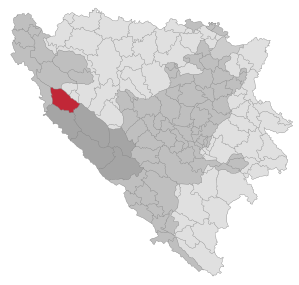Drvar
|
Drvar Дрвар |
||
|
|
||
| Basic data | ||
|---|---|---|
| State : | Bosnia and Herzegovina | |
| Entity : | Federation of BiH | |
| Canton : | 10 | |
| Coordinates : | 44 ° 22 ' N , 16 ° 23' E | |
| Height : | 475 m. i. J. | |
| Area : | 589.3 km² | |
| Residents : | 7,036 (2013) | |
| Population density : | 12 inhabitants per km² | |
| Telephone code : | +387 (0) 34 | |
| Structure and administration (as of 2016) | ||
| Mayor : | Goran Broćeta ( SNSD ) | |
| Website : | ||
Drvar ( Serbian - Cyrillic Дрвар ) is a small town and municipality of the same name in western Bosnia and Herzegovina . It lies on the Unac , a right tributary of the Una in Canton 10 of the Federation of Bosnia and Herzegovina .
The name of the city comes from the Serbo-Croatian word drvo for "wood". At times Drvar was called Titov Drvar .
geography
Drvar lies in a valley basin of the Unac between the wooded mountain ranges Osječenica (1791 m) in the north-west, Klekovača (1961 m) in the north-east and Vijenac (1539 m) in the south. The city is about 12 km as the crow flies from the Croatian border. The entity boundary to the Republika Srpska runs on the Klekovača ridge 10 km away.
population
Before the Bosnian War , Bosnian Serbs made up the majority of the population of Drvar. The city had about 8,000 inhabitants in 1991, the municipality about 17,000.
Due to the expulsions and resettlements during the war, the Croatians made up the majority of the population in 1998. By 2005, many of the people who had fled had returned, so that the majority situation is again similar to that of the pre-war period. However, the total number of inhabitants of the municipality was only around 7,000 at the 2013 census, which is less than half as large as before the war. 91.2% of the inhabitants of the municipality described themselves as Serbs and 7.8% as Croatians .
history
From 1936 to 1939 the Serbian Orthodox Church of Saint Sava was built in the city center . In the Second World War had guerrillas of Josip Broz Tito of its headquarters in the mountains near Drvar. In May 1944, the SS and Wehrmacht tried in vain to arrest Tito and the partisan leadership at Operation Rösselsprung . Tito's hiding place can still be visited today.
After the collapse of Yugoslavia , Drvar, which was predominantly inhabited by Serbs, was initially controlled by the Republika Srpska , but was captured by Croatian troops in August 1995 . The Serbian population fled the little destroyed city. After the Treaty of Dayton this came to the Federation. The new residents were almost exclusively Croatians. The attempt by 350 Bosnian Serbs to return to their homeland in October 1996 was foiled by the inhabitants of the city at the time. In May 1997, houses formerly inhabited by Serbians were destroyed in a controlled manner in order to make it impossible to return.
In 1998 there were looting and riots in connection with the repatriation of Serb refugees. At least two people were killed in the process, and SFOR restored calm.
economy
The community is dominated by agriculture . In view of the extensive forests in the area, the timber industry plays a special role .
traffic
Drvar is located on the main road 14-2 ( Bosanski Petrovac - Bosansko Grahovo ) north of the Ploča pass (985 m). Other roads lead north of the Unac Gorge to Bihać and east through the valley to Prekaja .
There is no longer a train connection. Until 1978, Drvar had a station on the narrow-gauge stone ice railway from Prijedor and Jajce to Lička Kaldrma . The rail connections were discontinued in several stages. On June 1, 1969 the connection to Jaice, on June 1, 1975 the connection to Prijedor and on May 28, 1978 the last connection to Licka Kaldrma.
Personalities
The Prime Minister of Bosnia and Herzegovina, Nikola Špirić , who has been in office since January 2007 , was born in Drvar, as was the national handball player Marinko Kelečević . The singer Saša Matić also comes from Drvar.
literature
- Milan Ristović : Drvar. In: Dan Diner (Ed.): Encyclopedia of Jewish History and Culture (EJGK). Volume 2: Co-Ha. Metzler, Stuttgart / Weimar 2012, ISBN 978-3-476-02502-9 , pp. 160-165.
swell
- ↑ Agencija za statistiku Bosne i Hercegovine: Popis stanovništva, domaćinstava i stanova u Bosni i Hercegovini, 2013. Rezultati popisa. (pdf, 19.7 MB) Sarajevo, June 2016; P. 58
- ↑ Bosnia's Don Quixote (English; PDF; 1.4 MB), UNHCR publication Refugees vol 1, 1999, page 114
- Report on the return of refugees (1999) ( Memento of January 10, 2001 in the Internet Archive )
- Bosnia's Don Quixote (English; PDF; 1.4 MB), UNHCR publication Refugees vol 1, 1999, page 114
- House Burnings: Obstruction of the Right to Return to Drvar , International Crisis Group , June 16, 1997
- Impunity in Drvar , International Crisis Group , August 20, 1998
Web links
- Official municipality website (Serbo-Croatian)





